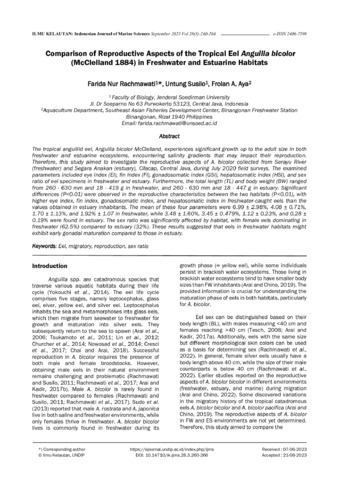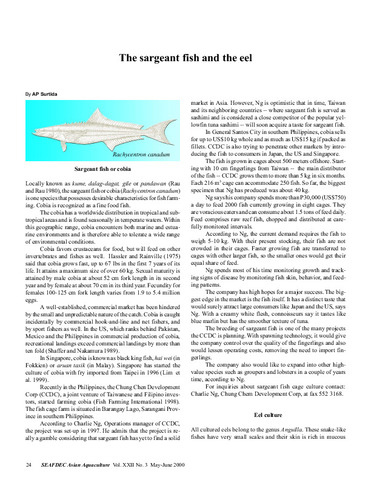Comparison of reproductive aspects of the tropical eel Anguilla bicolor (McClelland 1884) in freshwater and estuarine habitats
- Global styles
- MLA
- Vancouver
- Elsevier - Harvard
- APA
- Help

Download URL
ejournal.undip.ac.id日付
2023-09-07Page views
383ASFA keyword
AGROVOC keyword
Taxonomic term
Geographic names
Metadata
アイテムの詳細レコードを表示するCited times in Scopus
- Citations
- Scopus - Citation Indexes: 1
- Captures
- Mendeley - Readers: 8
- Mentions
- News: 1
Share
抄録
The tropical anguillid eel, Anguilla bicolor McClelland, experiences significant growth up to the adult size in both freshwater and estuarine ecosystems, encountering salinity gradients that may impact their reproduction. Therefore, this study aimed to investigate the reproductive aspects of A. bicolor collected from Serayu River (freshwater) and Segara Anakan (estuary), Cilacap, Central Java, during July 2020 field surveys. The examined parameters included eye index (EI), fin index (FI), gonadosomatic index (GSI), hepatosomatic index (HSI), and sex ratio of eel specimens in freshwater and estuary. Furthermore, the total length (TL) and body weight (BW) ranged from 260 - 630 mm and 18 - 419 g in freshwater, and 260 - 630 mm and 18 - 447 g in estuary. Significant differences (P<0.01) were observed in the reproductive characteristics between the two habitats (P<0.01), with higher eye index, fin index, gonadosomatic index, and hepatosomatic index in freshwater-caught eels than the values obtained in estuary inhabitants. The mean of these four parameters were 6.99 ± 2.98%, 4.08 ± 0.71%, 1.70 ± 1.13%, and 1.92% ± 1.07 in freshwater, while 3.48 ± 1.60%, 3.45 ± 0.479%, 1.12 ± 0.23%, and 0.28 ± 0.19% were found in estuary. The sex ratio was significantly affected by habitat, with female eels dominating in freshwater (62.5%) compared to estuary (32%). These results suggested that eels in freshwater habitats might exhibit early gonadal maturation compared to those in estuary.
Keywords
eel migratory reproduction sex ratioSuggested Citation
Rachmawati, F. N., Susilo, U., & Aya, F. (2023). Comparison of reproductive aspects of the tropical eel Anguilla bicolor (McClelland 1884) in freshwater and estuarine habitats. Ilmu Kelautan: Indonesian Journal of Marine Sciences , 28(3), 260-266. https://doi.org/10.14710/ik.ijms.28.3.260-266
Type
ArticleISSN
0853-7291; 2406-7598Collections
- Journal Articles [1249]
Except where otherwise noted, this item's license is described as Attribution-ShareAlike 4.0 International
Related items
Showing items related by title, author, creator and subject.
-
High genetic diversity in anguillid glass eels across three Southeast Asian countries revealed through mitochondrial DNA D-loop sequences, with notes on population structure
Marini, Melfa; Pedrosa-Gerasmio, Ivane R.; Santos, Mudjekeewis ; Romana-Eguia, Maria Rowena R.
; Romana-Eguia, Maria Rowena R.  ; Nguyen, Binh Thanh; Shibuno, Takuro (Elsevier, 2024-09)
Understanding the genetic diversity and population structure of anguillid eels is crucial for effective management. In this study, we used the mitochondrial DNA (mtDNA) D-loop marker to identify anguillid glass eels and ...
; Nguyen, Binh Thanh; Shibuno, Takuro (Elsevier, 2024-09)
Understanding the genetic diversity and population structure of anguillid eels is crucial for effective management. In this study, we used the mitochondrial DNA (mtDNA) D-loop marker to identify anguillid glass eels and ... -
Alternate day feeding as a cost-effective strategy for tank culture of the Pacific shortfin eel Anguilla bicolor pacifica
Aya, Frolan ; Unida, John Carlo L.; Romana-Eguia, Maria Rowena R.
; Unida, John Carlo L.; Romana-Eguia, Maria Rowena R.  ; Salayo, Nerissa D. (College of Agriculture and Food Science, University of the Philippines Los Baños, 2023-09)
There is a growing interest in the aquaculture of tropical anguillid eels as an export commodity. However, studies on feeding strategies, and the present demand to reduce feed costs need to be addressed to ensure the ...
; Salayo, Nerissa D. (College of Agriculture and Food Science, University of the Philippines Los Baños, 2023-09)
There is a growing interest in the aquaculture of tropical anguillid eels as an export commodity. However, studies on feeding strategies, and the present demand to reduce feed costs need to be addressed to ensure the ... -
The sargeant fish and the eel
Surtida, Augusto P. (Aquaculture Department, Southeast Asian Fisheries Development Center, 2000)The culture of sargeant fish, or cobia (Rachycentron canadum) and eel (Anguilla spp) in the Philippines is discussed. Market potentials for the cultured products are examined.








